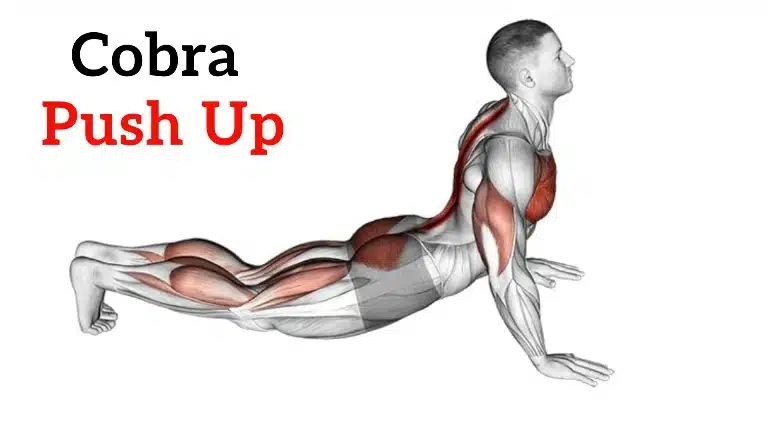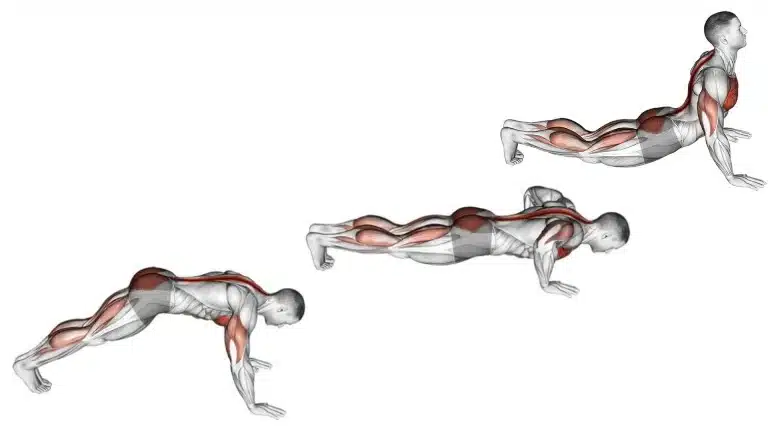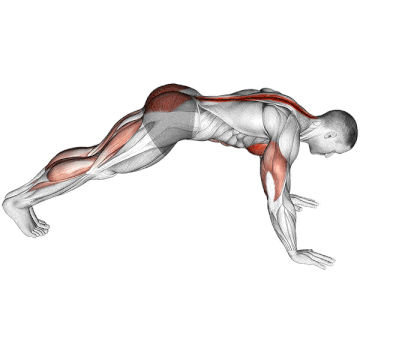The Cobra Push-Up, also known as the Bhujangasana Push-Up, is a hybrid movement that combines yogic stretching with dynamic upper body engagement.
A Cobra Push-Up involves transitioning between a plank-like position and the cobra yoga pose in a rhythmic, flowing motion. Unlike a standard push-up that emphasises pressing strength, this movement enhances flexibility, spinal decompression, and core activation.
It represents the intersection of strength, mobility, coordination, and muscle building. It improves athletic movement quality, leading to better performance in a wide range of physical activities.
It targets your chest and triceps while engaging your core and back muscles for an added challenge.
When my clients do Cobra Push-Ups regularly, I’ve seen big improvements in their lower back pain and thoracic extension. This exercise is especially helpful for clients dealing with:
- Forward head posture
- Rounded shoulders
- Limited spinal mobility

- Cobra Push-Up Muscles Worked
- How to Do Cobra Push-Up
- Tips and Techniques
- Cobra Push-Up Variations (Make It Easier Or Harder)
- 1. Cobra Pose (Bhujangasana)
- 2. Knee Cobra Push Up
- 3. Pike To Cobra Push Up
- FAQs
- 1. Are Cobra push-ups good for building muscle mass?
- 2. Can Cobra Push-Ups help improve my posture?
- References:
Cobra Push-Up Muscles Worked
The cobra push-up is a compound exercise that targets multiple muscle groups, including:
- Primary Muscles: Spinal Erectors (Erector Spinae), Chest muscles (pectoralis major and minor) and Triceps Brachii
- Secondary Muscles: Deltoids (Anterior Head), core muscles (Rectus Abdominis, Obliques)
- Stabilizing Muscles: Transverse Abdominis, Gluteus Maximus, Serratus Anterior and Forearm Flexors and Extensors

How to Do Cobra Push-Up
- Lie prone (face down) on an exercise mat.
- Extend your legs straight behind you. They can be hip-width apart or together – find what feels most stable. Engage your quads and glutes lightly from the start.
- Place your hands directly under your shoulders, or even slightly narrower (closer to your ribcage).
- Your fingers should point forward, or slightly turned outwards if that’s more comfortable for your wrists.
- Lightly draw your navel towards your spine to support your lower back.
- Press hard into your palms and push the floor away. Simultaneously with the press, start to lift your head, then your chest, off the floor.
- Actively arch through your upper and mid-back (thoracic spine) to create the “Cobra” shape. Your gaze will naturally lift forward and slightly upward – avoid cranking your neck back excessively.
- Continue pressing until your arms are almost fully extended. Maintain a slight micro-bend in your elbows to keep tension on the muscles and protect the joint.
- INHALE, slowly and with control, begin to lower your body back towards the mat.
- Reverse the movement: allow your spine to gently lengthen as your chest and head move towards the floor.
- Lower until your chest and forehead (or chin) lightly touch the mat, returning to the starting position.
Know More: 100+ Chest Exercises That You can Do With Dumbbell, Barbell, Cable, Band And Bodyweight
Tips and Techniques
- Before you even start the movement, actively pull your shoulder blades down (away from your ears – depression) and gently squeeze them together (towards your spine – retraction).
- Keep your elbows tight to your sides throughout the entire movement – both pushing up and lowering down.
- Keep your core engaged throughout the entire movement to help stabilize the body and protect your lower back.
- Maintain a relatively neutral neck position. Your gaze will naturally follow the movement, looking slightly down at the start, forward, and then slightly up at the peak.
- Focus on feeling the target muscles working rather than just completing the movement. Visualise your spine extending vertebra by vertebra as you rise up into the cobra position.
- Coordinate your breath with the movement. A proper breathing pattern enhances core stability and helps maintain form throughout the exercise.

Cobra Push-Up Variations (Make It Easier Or Harder)
There are several variations of the cobra push-up that can be used to add variety to your workout routine and challenge different muscle groups:
- Try beginner-friendly yoga poses and Knee cobra push-ups to make cobra push-ups easier.
- To make pushups harder, you can use any of the variations of Pike to Cobra Push or resistance band Cobra Push.
1. Cobra Pose (Bhujangasana)
Cobra Pose (Bhujangasana), a classic yoga poses, captures the spirit of the “cobra push-up”. It’s all about safely moving your spine, strengthening your back muscles, and opening up your chest, rather than relying on arm strength.
It’s a fantastic choice for beginners and makes for a great warm-up.
It works best for people who are just starting out with back extension exercises, have little upper body strength, or want to gradually increase their spinal mobility.
How To Do
- Lie face down on your mat, legs extended, and the tops of your feet rest on the floor.
- Place your hands flat on the floor directly under your shoulders, fingers pointing forward, elbows tucked close to your ribcage.
- Inhale and gently press into your hands and begin to lift your head and chest off the floor.
- Keep your shoulders relaxed and away from your ears. Draw them down your back.
- Your hips and legs should remain on the floor. Lift only as high as you can comfortably without straining your lower back.
- Hold for a few breaths (e.g., 15-30 seconds), feeling the stretch in your chest and abdomen, and the engagement in your back.
- Exhale and slowly lower back down.
2. Knee Cobra Push Up
The Knee cobra push-up, also known as the modified Cobra push-up, is a variation of the traditional Cobra push-up. It is suitable for people new to exercise or with limited upper body strength.
This push-up variation is performed on the knees instead of the toes. It is a great way to build the strength and stability needed to progress to the full Cobra press-up.
How To Do
- Start by kneeling on the floor with your hands placed slightly wider than shoulder-width apart.
- Keep your elbows close to your body.
- Lower your body towards the ground as you would in a knee push-up, but as you push back up, lift your hips and arch your back, creating a “cobra” shape with your body.
- Keep your hands and feet on the ground and your core engaged throughout the movement.
3. Pike To Cobra Push Up
This dynamic and challenging movement combines elements of a Pike Push-Up (shoulder-dominant) with the Cobra Push-Up. It improves strength, mobility, and coordination through a greater range of motion.
It will also help to stretch your groin, abs, and hip flexors, but to a lesser degree.
How To Do
- Start in a standard push-up position.
- Lift the hips up and back until your body forms an inverted V shape.
- Bend your elbows and lower your chest until it’s just above the floor, going into a low plank pose.
- In a scooping motion, scoop your head upward while arching your lower and upper back and go into cobra pose.
- You do not need to reverse back through the sweeping, arching motion to return to the starting position.
- Push back into the starting position.
FAQs
1. Are Cobra push-ups good for building muscle mass?
While Cobra Push-Ups are excellent for muscle endurance, functional strength, and mobility, they may not be optimal for maximum muscle hypertrophy compared to progressive overload with weights.
However, advanced variations can contribute to muscle development, particularly for beginners or when performed with high volume and proper nutrition.
2. Can Cobra Push-Ups help improve my posture?
Yes, Cobra Push-Ups are excellent for posture improvement. They strengthen the posterior chain muscles that support proper spinal alignment while stretching the anterior muscles (chest, shoulders, abdominals), which tend to tighten with prolonged sitting.
References:
- Choi SH, Lee BH. Clinical Usefulness of Shoulder Stability Exercises for Middle-aged Women. J Phys Ther Sci. 2013 Oct;25(10):1243-6. doi: 10.1589/jpts.25.1243. Epub 2013 Nov 20. PMID: 24259767; PMCID: PMC3820191.
- Choi SH, Lee BH. Clinical Usefulness of Shoulder Stability Exercises for Middle-aged Women. J Phys Ther Sci. 2013 Oct;25(10):1243-6. doi: 10.1589/jpts.25.1243. Epub 2013 Nov 20. PMID: 24259767; PMCID: PMC3820191.

Manish is a NASM-certified fitness and nutrition coach with over 10 years of experience in weight lifting and fat loss fitness coaching. He specializes in gym-based training and has a lot of knowledge about exercise, lifting technique, biomechanics, and more.
Through “Fit Life Regime,” he generously shares the insights he’s gained over a decade in the field. His goal is to equip others with the knowledge to start their own fitness journey.
